Cancer Therapy Market Size
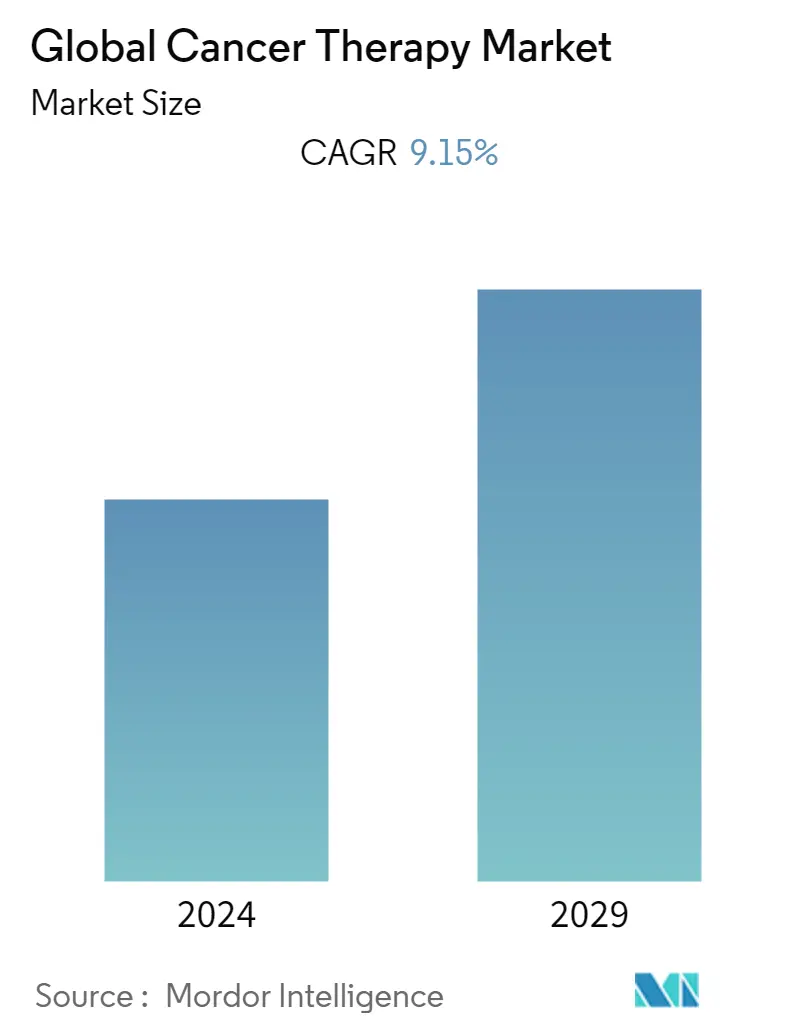
| Study Period | 2018 - 2028 |
| Base Year For Estimation | 2021 |
| CAGR | 9.15 % |
| Fastest Growing Market | Asia Pacific |
| Largest Market | North America |
| Market Concentration | Medium |
Major Players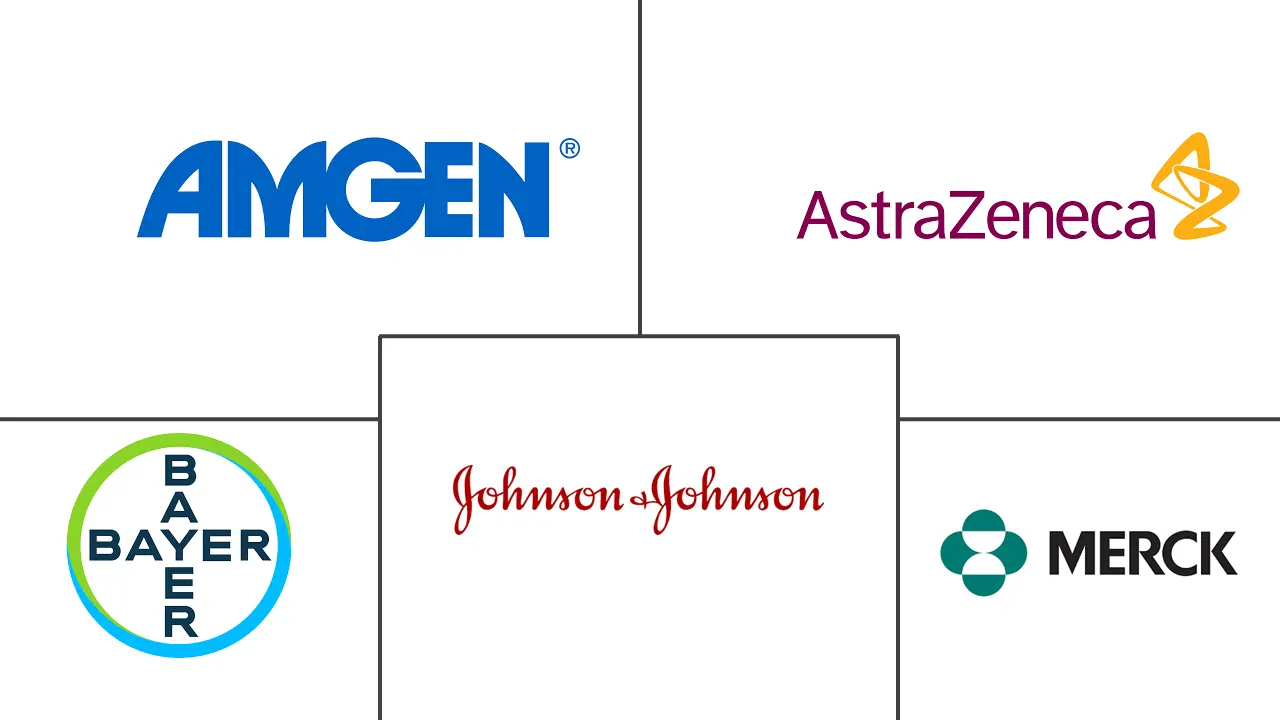
*Disclaimer: Major Players sorted in no particular order |
Need a report that reflects how COVID-19 has impacted this market and its growth?
Cancer Therapy Market Analysis
The global cancer therapy market was valued at approximately USD 158 billion in 2020, and it is expected to witness a revenue of USD 268 billion in 2026, with a CAGR of 9.15% over the forecast period.
The COVID-19 pandemic has affected the healthcare systems globally and also has a significant impact on the cancer therapy market. As per the article published in Cancer Connect 2020, doctors from Dana Farber Cancer Institute determined that during the COVID-19 pandemic, there was a 46% decrease in the diagnoses of the six most common cancer types - breast, colorectal, lung, pancreatic, gastric, and esophageal cancers. Also, the Centers for Disease Control and Prevention (CDC) and many medical professional organizations recommended that cancer screening and other health prevention services, along with elective surgeries, to be postponed unless the risks outweighed the benefits and to secure the hospital infrastructure for the treatment of COVID-19 patients. Thus, the COVID-19 pandemic has impacted the cancer therapy market. However, the situation is expected to gradually improve.
The global cancer therapy market is estimated to register a CAGR of 9.15% during the forecast period. The factors that are driving the market growth include increasing patient assistance programs (PAPs), increasing government initiatives for cancer awareness, rising prevalence of cancer worldwide, and strong R&D initiatives from key players, along with the increasing demand for personalized medicine.
According to the Globocan 2020 fact sheet, an estimated 19,292,789 new cancer cases were diagnosed worldwide, with nearly 9,958,133 deaths due to cancers, globally. Additionally, according to estimates from the International Agency for Research on Cancer (IARC), by 2040, the global burden of cancers is expected to grow to 27.5 million new cancer cases and 16.3 million deaths worldwide. The increasing incidence of cancer cases is expected to drive the need for advanced cancer therapies for the effective treatment of patients. Thus, given the aforementioned factors, the cancer therapy market is expected to witness tremendous growth over the forecast period.
Cancer Therapy Market Trends
This section covers the major market trends shaping the Cancer Therapy Market according to our research experts:
The Targeted Therapy Segment is Expected to Show the Fastest Growth in the Forecast Period
Targeted therapy is a treatment used for cancer, in which the drugs work by targeting the specific genes or proteins that are present in the cancer cells. There are several types of targeted therapies for cancers, such as hormone therapies, gene expression modulators, apoptosis inducers, angiogenesis inhibitors, signal transduction inhibitors, and many other therapies.
In the COVID-19 era, nearly 88% of the cancer care centers faced challenges in delivering usual cancer care for many reasons, including precautionary measures, lack of personal protective equipment, and staff shortage as per the research article published in the JCO Global Oncology 2020. Additionally, this impact was more pronounced in low-income countries. Therefore, COVID-19 is expected to hinder the number of cancer therapies offered to cancer patients, which is expected to impact the studied segment.
Targeted therapy is a rapidly growing field of cancer research, and researchers are studying many new targets. For example, the human epidermal growth factor receptor 2 protein (HER-2) is expressed at high levels on the surface of some cancer cells. Several targeted therapies are directed against HER-2, including trastuzumab (Herceptin), which is approved to treat certain breast and stomach cancers that overexpress HER-2. In April 2020, the US FDA approved Trodelvy (sacituzumab govitecan-hziy) for the treatment of adult patients with triple-negative breast cancer. Trodelvy is a Trop-2-directed antibody and topoisomerase inhibitor drug conjugate, which targets the Trop-2 receptor that helps cancer grow, divide, and spread. Additionally, in May 2020, the US FDA approved Tabrecta (capmatinib) for the treatment of adult patients with non-small cell lung cancer (NSCLC), and it is the first FDA-approved targeted therapy to treat NSCLC with specific mutations. Thus, in view of the increasing product approvals and high research activities related to targeted therapies against cancers, the studied segment is expected to grow over the forecast period.
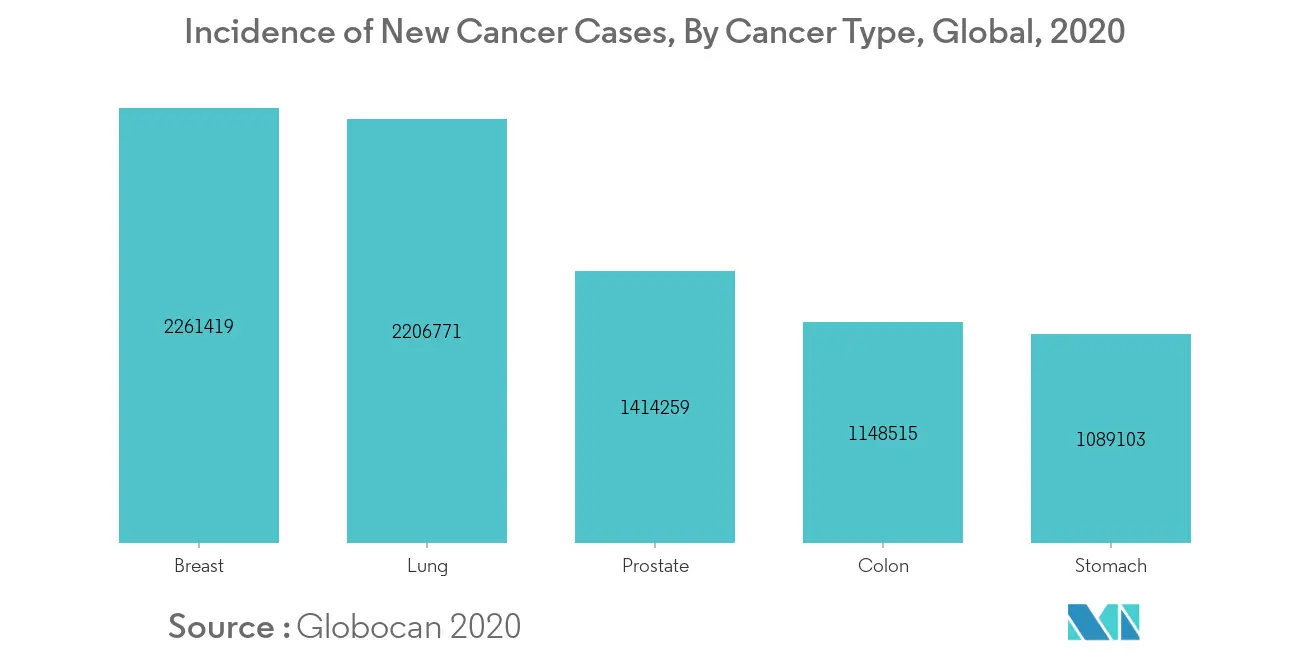
North America Currently Dominates the Cancer Therapy Market and is Expected to Continue in the Forecast Period
North America is expected to increase its market share in the future, owing to the increased adoption of cancer therapy and the growing burden of cancers in the United States. According to the Globocan 2020 report, an estimated 2,281,658 new cancer cases were diagnosed in the United States in 2020, with nearly 612,390 deaths. In 2020, The most common cancers were breast (253,465), lung (227,875), prostate (209,512), and colon (101,809) in the United States.
Additionally, the high concentration of key players in North America, increasing FDA approvals along with strategic alliances, and high investment in research and development activities are expected to boost the market in the region. For instance, in November 2020, Merck & Co. Inc entered into a definitive agreement to acquire Velosbio Inc., which is a privately held clinical-stage biopharmaceutical company committed to developing first-in-class cancer therapies targeting receptor tyrosine kinase-like orphan receptor 1 (ROR1). Similarly, in March 2020, Johnson and Johnson received the US FDA Breakthrough Therapy Designation for JNJ-61186372 (JNJ-6372) for the treatment of patients with metastatic non-small cell lung cancer (NSCLC). Thus, given the aforementioned factors, the cancer therapy market is expected to grow significantly over the forecast period in North America.
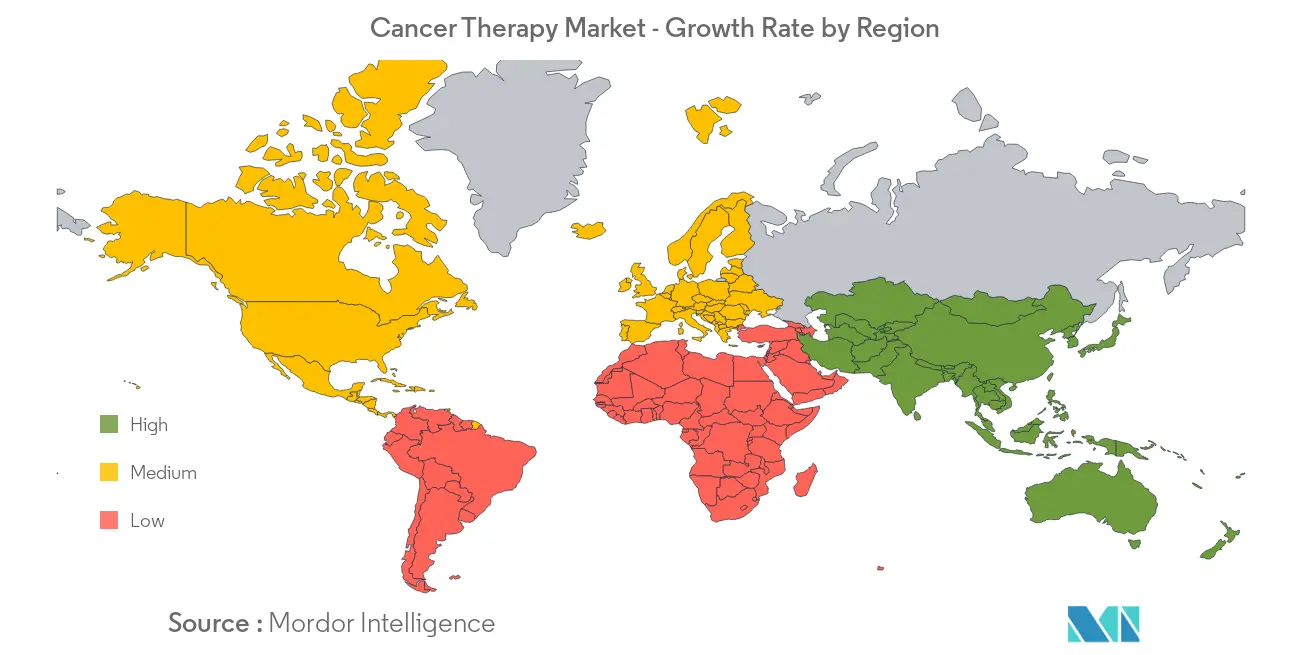
Cancer Therapy Industry Overview
The cancer therapy market is highly competitive and consists of several major players. In terms of market share, a few of the major players currently dominate the market. The players, namely, Amgen Inc., AstraZeneca plc, Bayer AG, Bristol-Myers Squibb Company, Pfizer Inc, Novartis AG, and Johnson and Johnson, hold significant shares in the cancer therapy market. The strategic alliances and the increasing investment in research on oncology by the key players aid in securing their position and presence worldwide. For instance, in January 2019, GlaxoSmithKline PLC acquired TESARO Inc., an oncology-based biopharmaceutical company, leading to the expansion of GSK's pipeline and commercial capability in oncology.
Cancer Therapy Market Leaders
Amgen Inc.
AstraZeneca PLC
Bayer AG
Johnson and Johnson
Merck & Co. Inc.
*Disclaimer: Major Players sorted in no particular order
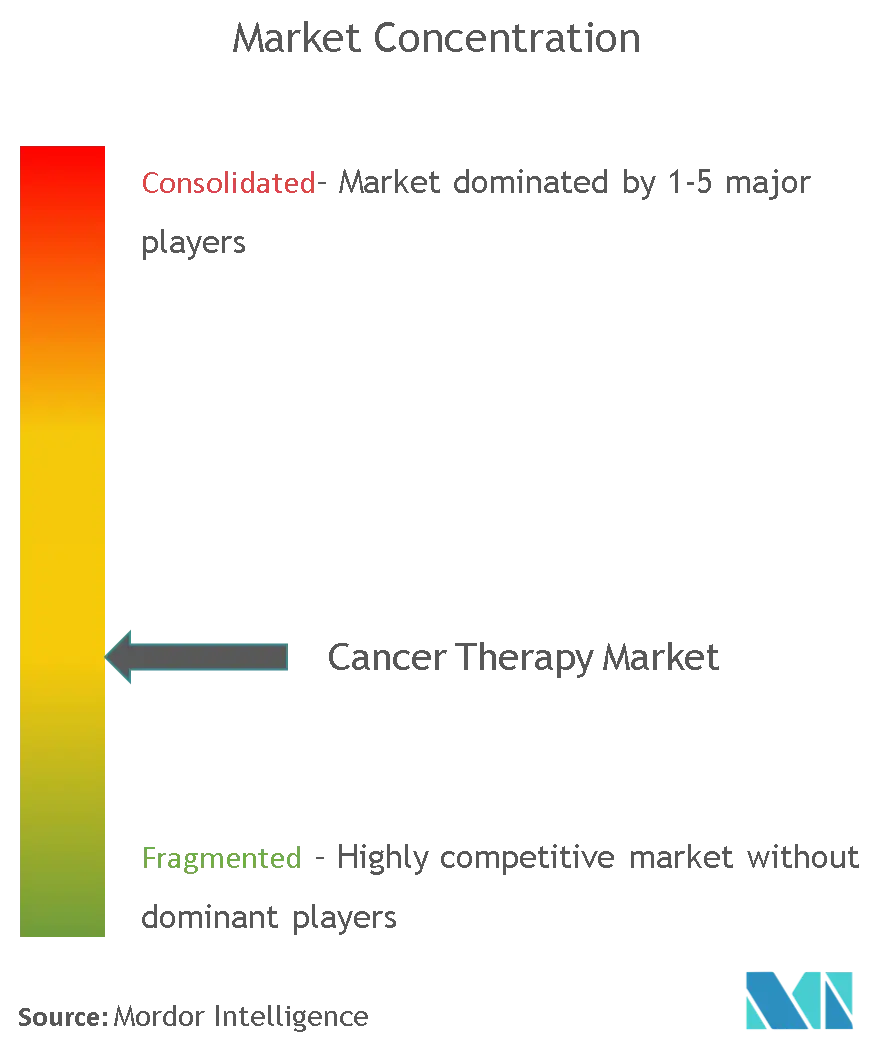
Cancer Therapy Market News
In May 2021, Amgen's LUMAKRAS (sotorasib) was approved by the U.S. Food and Drug Administration (FDA) for the treatment of adult patients with KRAS G12C-mutated locally advanced or metastatic non-small cell lung cancer (NSCLC).
In May 2021, Cadila Healthcare launched Trastuzumab Emtansine, one of the first Antibody Drug Conjugate (ADC) biosimilar for treating both early and advanced HER2 positive breast cancer.
Cancer Therapy Market Report - Table of Contents
1. INTRODUCTION
1.1 Study Assumptions and Market Definition
1.2 Scope of the Study
2. RESEARCH METHODOLOGY
3. EXECUTIVE SUMMARY
4. MARKET DYNAMICS
4.1 Market Overview
4.2 Market Drivers
4.2.1 Increasing Patient Assistance Programs (PAPs) and Rising Demand for Personalized Medicine
4.2.2 Growing Government Initiatives for Cancer Awareness
4.2.3 Rising Prevalence of Cancer Worldwide
4.2.4 Strong R&D Initiatives from Key Players
4.3 Market Restraints
4.3.1 Fluctuation in Reimbursement Policies
4.3.2 High Cost of Cancer Therapies
4.4 Porter's Five Forces Analysis
4.4.1 Threat of New Entrants
4.4.2 Bargaining Power of Buyers/Consumers
4.4.3 Bargaining Power of Suppliers
4.4.4 Threat of Substitute Products
4.4.5 Intensity of Competitive Rivalry
5. MARKET SEGMENTATION
5.1 Therapy Type
5.1.1 Chemotherapy
5.1.2 Targeted Therapy
5.1.3 Immunotherapy
5.1.4 Hormonal Therapy
5.1.5 Other Treatment Types
5.2 Cancer Type
5.2.1 Blood Cancer
5.2.2 Breast Cancer
5.2.3 Prostate Cancer
5.2.4 Gastrointestinal Cancer
5.2.5 Gynaecologic Cancer
5.2.6 Respiratory/Lung Cancer
5.2.7 Other Cancer Types
5.3 End User
5.3.1 Hospitals
5.3.2 Specialty Clinics
5.3.3 Cancer and Radiation Therapy Centers
5.4 Geography
5.4.1 North America
5.4.1.1 United States (By Therapy Type, By Cancer Type, and By End User)
5.4.1.2 Canada (By Therapy Type, By Cancer Type, and By End User)
5.4.1.3 Mexico (By Therapy Type, By Cancer Type, and By End User)
5.4.2 Europe
5.4.2.1 Germany (By Therapy Type, By Cancer Type, and By End User)
5.4.2.2 United Kingdom (By Therapy Type, By Cancer Type, and By End User)
5.4.2.3 France (By Therapy Type, By Cancer Type, and By End User)
5.4.2.4 Italy (By Therapy Type, By Cancer Type, and By End User)
5.4.2.5 Spain (By Therapy Type, By Cancer Type, and By End User)
5.4.2.6 Rest of Europe (By Therapy Type, By Cancer Type, and By End User)
5.4.3 Asia-Pacific
5.4.3.1 China (By Therapy Type, By Cancer Type, and By End User)
5.4.3.2 Japan (By Therapy Type, By Cancer Type, and By End User)
5.4.3.3 India (By Therapy Type, By Cancer Type, and By End User)
5.4.3.4 Australia (By Therapy Type, By Cancer Type, and By End User)
5.4.3.5 South Korea (By Therapy Type, By Cancer Type, and By End User)
5.4.3.6 Rest of Asia-Pacific (By Therapy Type, By Cancer Type, and By End User)
5.4.4 Middle-East and Africa
5.4.4.1 GCC (By Therapy Type, By Cancer Type, and By End User)
5.4.4.2 South Africa (By Therapy Type, By Cancer Type, and By End User)
5.4.4.3 Rest of Middle-East and Africa (By Therapy Type, By Cancer Type, and By End User)
5.4.5 South America
5.4.5.1 Brazil (By Therapy Type, By Cancer Type, and By End User)
5.4.5.2 Argentina (By Therapy Type, By Cancer Type, and By End User)
5.4.5.3 Rest of South America (By Therapy Type, By Cancer Type, and By End User)
6. COMPETITIVE LANDSCAPE
6.1 Company Profiles
6.1.1 Amgen Inc.
6.1.2 Astrazeneca PLC
6.1.3 Bayer AG
6.1.4 Johnson and Johnson
6.1.5 Merck & Co. Inc.
6.1.6 F.Hoffmann-La Roche AG
6.1.7 Eli Lilly and Company
6.1.8 Novartis AG
6.1.9 Pfizer Inc.
6.1.10 Abbvie Inc.
6.1.11 Astellas Pharma Inc.
6.1.12 Celgene Corporation
6.1.13 GlaxoSmithKline PLC
6.1.14 Takeda Pharmaceutical Company Ltd
6.1.15 Bristol Myers Squibb Company
6.1.16 Gilead Sciences Inc. (Kite Pharma)
6.1.17 Ziopharm Oncology Inc.
6.1.18 Celldex Therapeutics Inc.
- *List Not Exhaustive
7. MARKET OPPORTUNITIES AND FUTURE TRENDS
Cancer Therapy Industry Segmentation
As per the scope of the report, cancer therapies are drugs that block the growth and proliferation of cancer, by interfering with specific molecules, such as DNA or proteins, which are involved in the growth or expansion of cancerous cells. These therapies include surgery, radiation therapy, chemotherapy, immunotherapy, etc. The cancer therapy market is segmented by therapy type, cancer type, end user, and geography. By therapy type, the market is segmented into chemotherapy, targeted therapy, immunotherapy, hormonal therapy, and other therapy types. By cancer type, the market is segmented into blood cancer, breast cancer, prostate cancer, gastrointestinal cancer, gynecologic cancer, respiratory/lung cancer, and other cancer types. By end user, the market is segmented into hospitals, specialty clinics, and cancer and radiation therapy centers. By geography, the market is segmented into North America, Europe, Asia-Pacific, Middle-East and Africa, and South America. The report offers the value (in USD million) for the above segments.
| Therapy Type | |
| Chemotherapy | |
| Targeted Therapy | |
| Immunotherapy | |
| Hormonal Therapy | |
| Other Treatment Types |
| Cancer Type | |
| Blood Cancer | |
| Breast Cancer | |
| Prostate Cancer | |
| Gastrointestinal Cancer | |
| Gynaecologic Cancer | |
| Respiratory/Lung Cancer | |
| Other Cancer Types |
| End User | |
| Hospitals | |
| Specialty Clinics | |
| Cancer and Radiation Therapy Centers |
| Geography | ||||||||
| ||||||||
| ||||||||
| ||||||||
| ||||||||
|
Cancer Therapy Market Research FAQs
What is the current Global Cancer Therapy Market size?
The Global Cancer Therapy Market is projected to register a CAGR of 9.15% during the forecast period (2023-2028).
Who are the key players in Global Cancer Therapy Market?
Amgen Inc., AstraZeneca PLC, Bayer AG, Johnson and Johnson and Merck & Co. Inc. are the major companies operating in the Global Cancer Therapy Market.
Which is the fastest growing region in Global Cancer Therapy Market?
Asia Pacific is estimated to grow at the highest CAGR over the forecast period (2023-2028).
Which region has the biggest share in Global Cancer Therapy Market?
In 2023, the North America accounts for the largest market share in the Global Cancer Therapy Market.
Cancer Therapeutics Industry Report
Statistics for the 2023 Cancer Therapeutics market share, size and revenue growth rate, created by Mordor Intelligence™ Industry Reports. Cancer Therapeutics analysis includes a market forecast outlook to 2028 and historical overview. Get a sample of this industry analysis as a free report PDF download.
